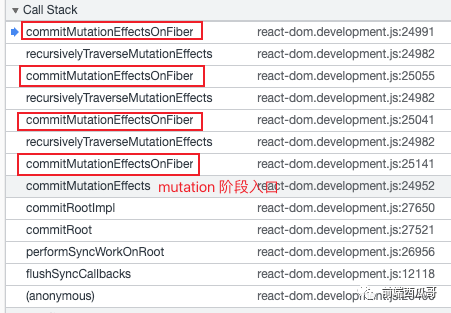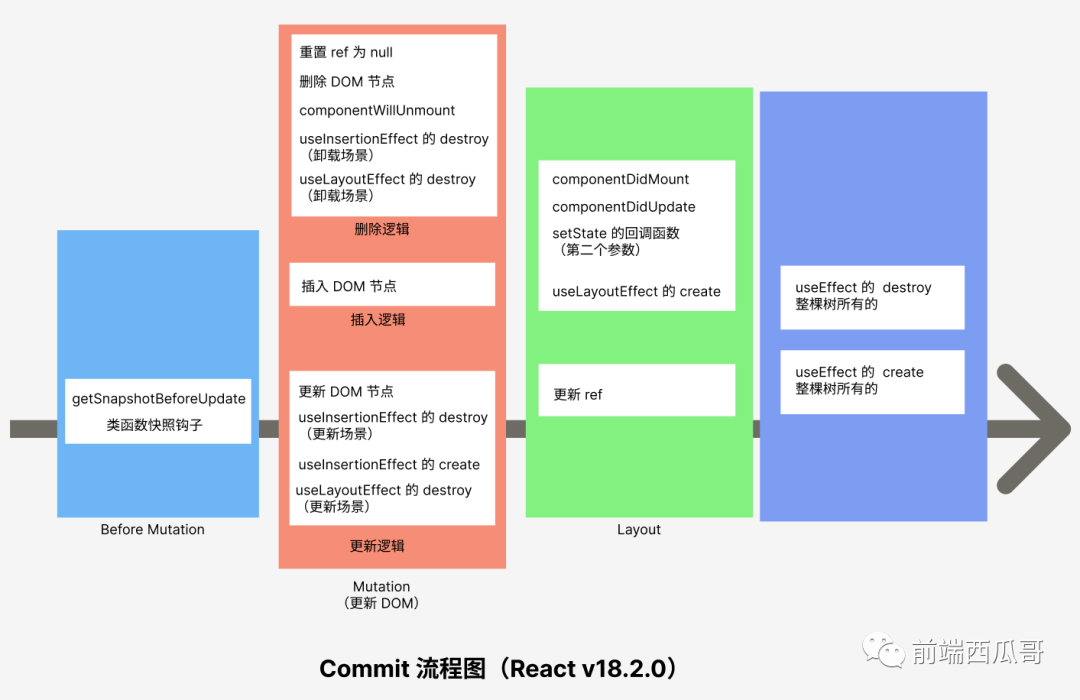
大家好,我是前端西瓜哥。今天我們來(lái)詳細(xì)講解一下 React 的 commit 階段的邏輯。
React 版本為 18.2.0
commit 分三個(gè)階段:
- BeforeMutation。
- Mutation:在這里更新 DOM。
- Layout。
commitRootImpl 中的三個(gè)函數(shù)的調(diào)用分別對(duì)應(yīng)這個(gè)三個(gè)階段:
function commitRootImpl(){
// BeforeMutation 階段
commitBeforeMutationEffects(root, finishedWork);
// Mutation 階段
commitMutationEffects(root, finishedWork, lanes);
// Layout 階段
commitLayoutEffects(finishedWork, root, lanes);
}一些標(biāo)記
在 reconcil (調(diào)和)階段,給 fiber 打了很多的 flags(標(biāo)記),commit 階段是會(huì)讀取這些 flags 進(jìn)行不同的操作的。
flags 是通過(guò)二進(jìn)制掩碼的方式來(lái)保存的,掩碼優(yōu)點(diǎn)是節(jié)省內(nèi)存,缺點(diǎn)是可讀性很差。
使用或位運(yùn)算,可以將多個(gè) flag 組合成一個(gè)組。
我這三個(gè)階段 用到的組合掩碼 為:
export const BeforeMutationMask =
Update |
Snapshot;
export const MutationMask =
Placement |
Update |
ChildDeletion |
ContentReset |
Ref |
Hydrating |
Visibility;
export const LayoutMask = Update | Callback | Ref | Visibility;
BeforeMutation 階段
BeforeMutation 階段。
commitRootImpl 首先會(huì) 調(diào)用 commitBeforeMutationEffects 方法。
commitBeforeMutationEffects 的核心實(shí)現(xiàn):
function commitBeforeMutationEffects(root, firstChild) {
nextEffect = firstChild;
commitBeforeMutationEffects_begin();
}主要是調(diào)用這個(gè) commitBeforeMutationEffects_begin 方法。
begin
begin 干了啥?
進(jìn)行深度優(yōu)先遍歷,找到最后一個(gè)帶有 BeforeMutation 標(biāo)識(shí)的 fiber。這是因?yàn)?useEffect 的調(diào)用邏輯是從子到父,要找最后一個(gè) fiber 作為起點(diǎn)。
commitBeforeMutationEffects_begin 的核心實(shí)現(xiàn):
function commitBeforeMutationEffects_begin() {
while (nextEffect !== null) {
const fiber = nextEffect;
// 取出子 fiber
const child = fiber.child;
if (
(fiber.subtreeFlags & BeforeMutationMask) !== NoFlags &&
child !== null
) {
// 說(shuō)明子 fiber 樹(shù)中存在 BeforeMutationMask 標(biāo)識(shí)的 fiber
// 那就繼續(xù)遍歷往下找
child.return = fiber;
nextEffect = child;
} else {
// 找不到了,說(shuō)明到底了,執(zhí)行 complete 邏輯。
commitBeforeMutationEffects_complete();
}
}
}subtreeFlags 是當(dāng)前 fiber 的子樹(shù)的標(biāo)識(shí)匯總,目的是防止無(wú)意義的完整深度遍歷,能夠更早地結(jié)束遍歷。如果直接用 flags,是要遍歷到葉子節(jié)點(diǎn)才能知道到底誰(shuí)是要找的最有一個(gè)節(jié)點(diǎn)。
找到后,調(diào)用 complete 。
complete
commitBeforeMutationEffects_complete 實(shí)現(xiàn)為:
function commitBeforeMutationEffects_complete() {
while (nextEffect !== null) {
const fiber = nextEffect;
try {
// BeforeMutation 階段真正做的事情
commitBeforeMutationEffectsOnFiber(fiber);
} catch (error) {
captureCommitPhaseError(fiber, fiber.return, error);
}
const sibling = fiber.sibling;
if (sibling !== null) { // 沒(méi)有下一個(gè)兄弟節(jié)點(diǎn)
sibling.return = fiber.return;
nextEffect = sibling;
return;
// 結(jié)束后會(huì)回到 begin 中的循環(huán)中
// 繼續(xù)往下找最后一個(gè) 帶有 BeforeMutation 標(biāo)識(shí)的 fiber
}
// 從上往下,處理
nextEffect = fiber.return;
}
}前面很多邏輯都是遍歷的邏輯,真正的核心操作在 commitBeforeMutationEffectsOnFiber 方法。
做了什么?
對(duì)標(biāo)記了 Snapshot 的組件進(jìn)行處理,通常是類(lèi)組件,會(huì) 調(diào)用類(lèi)組件實(shí)例 instance 的 getSnapshotBeforeUpdate 方法,生成快照對(duì)象,然后再放到 instance.__reactInternalSnapshotBeforeUpdate 下,作為之后的 componentDidUpdate 鉤子函數(shù)的第三個(gè)參數(shù)。
其他類(lèi)型的組件基本啥都不做。
function commitBeforeMutationEffectsOnFiber(finishedWork: Fiber) {
const current = finishedWork.alternate;
const flags = finishedWork.flags;
// flags 存在 Snapshot
if ((flags & Snapshot) !== NoFlags) {
switch (finishedWork.tag) {
case FunctionComponent:
case ForwardRef:
case SimpleMemoComponent: {
break;
}
// 類(lèi)組件
case ClassComponent: {
if (current !== null) {
const prevProps = current.memoizedProps;
const prevState = current.memoizedState;
const instance = finishedWork.stateNode;
// 調(diào)用類(lèi)組件實(shí)例的 getSnapshotBeforeUpdate 生成快照對(duì)象
const snapshot = instance.getSnapshotBeforeUpdate(
finishedWork.elementType === finishedWork.type
? prevProps
: resolveDefaultProps(finishedWork.type, prevProps),
prevState,
);
instance.__reactInternalSnapshotBeforeUpdate = snapshot;
}
break;
}
case HostRoot: {
if (supportsMutation) {
const root = finishedWork.stateNode;
clearContainer(root.containerInfo);
}
break;
}
case HostComponent:
case HostText:
case HostPortal:
case IncompleteClassComponent:
// 啥也不做
break;
default: {
throw new Error(
'This unit of work tag should not have side-effects. This error is ' +
'likely caused by a bug in React. Please file an issue.',
);
}
}
}
}Mutation 階段
mutation 階段是最重要的階段,在這個(gè)階段,React 真正地更新了文檔 DOM 樹(shù)。
入口函數(shù)是 commitMutationEffects,但它只是 commitMutationEffectsOnFiber 的封裝。
function commitMutationEffects(root, finishedWork, committedLanes) {
inProgressLanes = committedLanes;
inProgressRoot = root;
commitMutationEffectsOnFiber(finishedWork, root, committedLanes);
inProgressLanes = null;
inProgressRoot = null;
}每個(gè) fiber 都要傳入 commitMutationEffectsOnFiber,執(zhí)行 mutation 主邏輯。
從這調(diào)用棧可知 commitMutationEffectsOnFiber 遞歸調(diào)用了多次,形成了很長(zhǎng)的調(diào)用棧。

commitMutationEffectsOnFiber 的核心實(shí)現(xiàn)為:
function commitMutationEffectsOnFiber(finishedWork, root, lanes) {
const current = finishedWork.alternate;
const flags = finishedWork.flags;
switch (finishedWork.tag) {
case FunctionComponent:
case ForwardRef:
case MemoComponent:
case SimpleMemoComponent: {
// 做了一些事情
commitReconciliationEffects(finishedWork);
}
// 類(lèi)組件
case ClassComponent: {
recursivelyTraverseMutationEffects(root, finishedWork, lanes);
commitReconciliationEffects(finishedWork);
if (flags & Ref) {
if (current !== null) {
safelyDetachRef(current, current.return);
}
}
return;
}
}對(duì)不同類(lèi)型的 fiber 會(huì)進(jìn)行不同的處理,但有一些公共邏輯會(huì)執(zhí)行的,那就是:
// Deletion 深度遍歷執(zhí)行刪除操作
recursivelyTraverseMutationEffects(root, finishedWork, lanes);
// Placement 插入邏輯
commitReconciliationEffects(finishedWork);
刪除邏輯
首先是調(diào)用 recursivelyTraverseMutationEffects 方法,這個(gè)方法會(huì)執(zhí)行刪除邏輯。
該方法會(huì)讀取 fiber 的 deletions 數(shù)組,對(duì)這些要?jiǎng)h除的 fiber 進(jìn)行操作。
function recursivelyTraverseMutationEffects(root, parentFiber, lanes) {
// Deletions effects can be scheduled on any fiber type. They need to happen
// before the children effects hae fired.
const deletions = parentFiber.deletions;
if (deletions !== null) {
for (let i = 0; i < deletions.length; i++) {
const childToDelete = deletions[i];
try {
// 執(zhí)行 fiber 的刪除邏輯
commitDeletionEffects(root, parentFiber, childToDelete);
} catch (error) {
captureCommitPhaseError(childToDelete, parentFiber, error);
}
}
}
// 【下面的可不看】其實(shí)就是對(duì)子節(jié)點(diǎn)遍歷,也執(zhí)行 mutation 主邏輯。
if (parentFiber.subtreeFlags & MutationMask) {
let child = parentFiber.child;
while (child !== null) {
// 又調(diào)用 mutation 邏輯的入口函數(shù)
commitMutationEffectsOnFiber(child, root, lanes);
child = child.sibling;
}
}
}對(duì)于要?jiǎng)h除的 fiber,我們這里討論原生組件、類(lèi)組件、函數(shù)組件這 3 種組件類(lèi)型 fiber 的刪除邏輯。
【1】原生組件
對(duì)于原生組件類(lèi)型(div、span 這些):
- 首先將 綁定的 ref 置為 null。
- 先遞歸,對(duì)它的子 fiber 調(diào)用刪除邏輯。
- 然后 從 DOM 樹(shù)中刪除對(duì)應(yīng) DOM。
function commitDeletionEffectsOnFiber(finishedRoot, nearestMountedAncestor, deletedFiber) {
// deletedFiber 表示那個(gè)要被刪除的 fiber
switch (deletedFiber.tag) {
/********* 原生組件 *********/
case HostComponent: {
if (!offscreenSubtreeWasHidden) {
// ref 設(shè)置回 null
safelyDetachRef(deletedFiber, nearestMountedAncestor);
}
// 后面的 HostText 會(huì)接著執(zhí)行,switch 就是這個(gè)邏輯
}
case HostText: {
const prevHostParent = hostParent;
const prevHostParentIsContainer = hostParentIsContainer;
hostParent = null;
// 往下遍歷子節(jié)點(diǎn),執(zhí)行刪除
recursivelyTraverseDeletionEffects(
finishedRoot,
nearestMountedAncestor,
deletedFiber,
);
hostParent = prevHostParent;
hostParentIsContainer = prevHostParentIsContainer;
// 刪除真正的 DOM,調(diào)用了原生的 removeChild 方法
if (hostParent !== null) {
if (hostParentIsContainer) {
removeChildFromContainer(
((hostParent: any): Container),
(deletedFiber.stateNode: Instance | TextInstance),
);
} else {
removeChild(
((hostParent: any): Instance),
(deletedFiber.stateNode: Instance | TextInstance),
);
}
}
return;
}
// 其他組件類(lèi)型
}【2】類(lèi)組件
對(duì)于類(lèi)組件:
- 先重置 ref。
- 然后 調(diào)用 componentWillUnmount 方法。
- 最后遞歸,對(duì)它的子 fiber 調(diào)用刪除邏輯。
function commitDeletionEffectsOnFiber(finishedRoot, nearestMountedAncestor, deletedFiber) {
// deletedFiber 表示那個(gè)要被刪除的 fiber
switch (deletedFiber.tag) {
// ...
/********* 類(lèi)組件 *********/
case ClassComponent: {
if (!offscreenSubtreeWasHidden) {
// 移除 ref
safelyDetachRef(deletedFiber, nearestMountedAncestor);
const instance = deletedFiber.stateNode;
if (typeof instance.componentWillUnmount === 'function') {
// 調(diào)用類(lèi)組件實(shí)例的 componentWillUnmount 方法
safelyCallComponentWillUnmount(
deletedFiber,
nearestMountedAncestor,
instance,
);
}
}
// 遍歷子節(jié)點(diǎn)執(zhí)行刪除邏輯
recursivelyTraverseDeletionEffects(
finishedRoot,
nearestMountedAncestor,
deletedFiber,
);
return;
}
// ...
}
}【3】函數(shù)組件
對(duì)于函數(shù)組件:
- 遍歷它的 updateQueue 隊(duì)列,并通過(guò) effect 的 tag 來(lái)識(shí)別類(lèi)型來(lái)決定是否調(diào)用 destory 方法。對(duì) useInsertionEffect 和 useLayoutEffect,調(diào)用它們的 destory 方法。destroy 就是執(zhí)行 useInsertionEffect / useLayoutEffect 的回調(diào)函數(shù)所返回的函數(shù)。useEffect 則跳過(guò),不調(diào)用 destory 方法。
- 最后遞歸,對(duì)它的子 fiber 調(diào)用刪除邏輯。
function commitDeletionEffectsOnFiber(finishedRoot, nearestMountedAncestor, deletedFiber) {
// deletedFiber 表示那個(gè)要被刪除的 fiber
switch (deletedFiber.tag) {
// ...
/********* 函數(shù)組件 *********/
case FunctionComponent:
case ForwardRef:
case MemoComponent:
case SimpleMemoComponent: {
if (!offscreenSubtreeWasHidden) {
const updateQueue = deletedFiber.updateQueue;
if (updateQueue !== null) {
// 讀取 updateQueue 隊(duì)列,隊(duì)列用鏈表的方式保存
const lastEffect = updateQueue.lastEffect;
if (lastEffect !== null) {
const firstEffect = lastEffect.next;
let effect = firstEffect;
do {
const {destroy, tag} = effect;
if (destroy !== undefined) {
// 處理 useInsertionEffect 產(chǎn)生的副作用
// 執(zhí)行 useInsertionEffect 回調(diào)函數(shù)返回的函數(shù),即 destroy
if ((tag & HookInsertion) !== NoHookEffect) {
// safelyCallDestroy 只是加了 try-catch 去調(diào)用 destroy
safelyCallDestroy(
deletedFiber,
nearestMountedAncestor,
destroy,
);
// useLayoutEffect 同理
} else if ((tag & HookLayout) !== NoHookEffect) {
safelyCallDestroy(
deletedFiber,
nearestMountedAncestor,
destroy,
);
}
}
// 找下一個(gè) effect
effect = effect.next;
} while (effect !== firstEffect);
}
}
}
// 向下遞歸
recursivelyTraverseDeletionEffects(
finishedRoot,
nearestMountedAncestor,
deletedFiber,
);
return;
}
default: {
recursivelyTraverseDeletionEffects(
finishedRoot,
nearestMountedAncestor,
deletedFiber,
);
return;
}
}
}插入邏輯
完成刪除邏輯后,接著就是調(diào)用 commitReconciliationEffects,這個(gè)方法負(fù)責(zé)往真實(shí) DOM 樹(shù)中插入 DOM 節(jié)點(diǎn)。
commitReconciliationEffects 核心內(nèi)容:
function commitReconciliationEffects(finishedWork) {
const flags = finishedWork.flags;
if (flags & Placement) {
try {
// 執(zhí)行 Placement 插入邏輯
commitPlacement(finishedWork);
} catch (error) {
captureCommitPhaseError(finishedWork, finishedWork.return, error);
}
// 移除 Placement 標(biāo)志
finishedWork.flags &= ~Placement;
}
if (flags & Hydrating) {
finishedWork.flags &= ~Hydrating;
}
}如果 finishedWork 有 Placement 標(biāo)識(shí),則調(diào)用 commitPlacement 方法。
commitPlacement 的邏輯為:
- 如果 finishedWork 還有 ContentReset 標(biāo)識(shí),先清空標(biāo)簽體,通過(guò)parent.textContent = '' 的方式。
- 接著是執(zhí)行插入邏輯。會(huì)嘗試找下一個(gè)兄弟節(jié)點(diǎn),存在會(huì)原生的 insertBefore 方法插入,不存在則使用 appendChild 方法。
commitPlacement 實(shí)現(xiàn)如下。
function commitPlacement(finishedWork) {
// 獲取父 fiber
const parentFiber = getHostParentFiber(finishedWork);
switch (parentFiber.tag) {
case HostComponent: {
const parent = parentFiber.stateNode;
// 父 fiber 是否有 ContentReset(內(nèi)容重置)標(biāo)記
if (parentFiber.flags & ContentReset) {
// 其實(shí)就是 parent.textContent = '';
resetTextContent(parent); //
// 移除 ContentReset 標(biāo)志
parentFiber.flags &= ~ContentReset;
}
// 找它的下一個(gè)兄弟 DOM 節(jié)點(diǎn),后面用 insertBefore 方法
// 如果沒(méi)有,就調(diào)用原生的 appendChild 方法
const before = getHostSibling(finishedWork);
insertOrAppendPlacementNode(finishedWork, before, parent);
break;
}
case HostRoot:
case HostPortal: {
const parent: Container = parentFiber.stateNode.containerInfo;
const before = getHostSibling(finishedWork);
insertOrAppendPlacementNodeIntoContainer(finishedWork, before, parent);
break;
}
// eslint-disable-next-line-no-fallthrough
default:
throw new Error(
'Invalid host parent fiber. This error is likely caused by a bug ' +
'in React. Please file an issue.',
);
}
}Placement 只會(huì)在原生組件和 fiber 根節(jié)點(diǎn)上標(biāo)記,沒(méi)有函數(shù)組件和類(lèi)組件什么事。
更新邏輯
對(duì)于可復(fù)用的原生組件,會(huì) 調(diào)用 commitUpdate 進(jìn)行更新。
commitUpdate 的代碼:
function commitUpdate(domElement, updatePayload, type, oldProps, newProps) {
// 對(duì)比更新,需要處理 onXx、className 這些特殊的 props
updateProperties(domElement, updatePayload, type, oldProps, newProps);
// 更新 DOM 元素的 "__reactProps$ + randomKey" 為這個(gè)新的 props
updateFiberProps(domElement, newProps);
}?類(lèi)組件不會(huì)進(jìn)行更新操作。
對(duì)于函數(shù)組件,會(huì)依次調(diào)用:
- useInsertionEffect 的回調(diào)函數(shù)函數(shù)返回的銷(xiāo)毀函數(shù)(保存在 effect.destroy 中)。
- useInsertionEffect 的回調(diào)函數(shù)(保存在 effect.create 中),調(diào)用完后將返回結(jié)果賦值個(gè) effect.destroy,下一次更新再調(diào)用。
- useLayoutEffect 的回調(diào)函數(shù)函數(shù)返回的銷(xiāo)毀函數(shù)。
需要注意,函數(shù)組件初次掛載,flags 也會(huì)標(biāo)記為 Update,走更新邏輯。這也是為什么 useEffect 在函數(shù)組件掛載時(shí)也會(huì)執(zhí)行,和類(lèi)組件的 componentDidUpate 不同。
// 找出 useInsertionEffect 的 destroy 方法去調(diào)用
// 需要注意 destroy 可能為 undefined(函數(shù)組件初次掛載的情況下)
commitHookEffectListUnmount(HookInsertion | HookHasEffect, finishedWork, finishedWork.return);
// 執(zhí)行 useInsertionEffect 的回調(diào)函數(shù),并將返回值保存到 effect.destory 里。
commitHookEffectListMount(HookInsertion | HookHasEffect, finishedWork);
// useLayoutEffect 對(duì)應(yīng)的 destroy 方法
// 同樣可能不存在
commitHookEffectListUnmount(HookLayout | HookHasEffect, finishedWork, finishedWork.return);
Layout
最后是 Layout 階段。
commitLayoutEffects 的實(shí)現(xiàn):
function commitLayoutEffects(finishedWork, root, committedLanes) {
inProgressLanes = committedLanes;
inProgressRoot = root;
nextEffect = finishedWork;
// 又是 begin,和 BeforeMutation 階段類(lèi)似的遞歸邏輯
commitLayoutEffects_begin(finishedWork, root, committedLanes);
inProgressLanes = null;
inProgressRoot = null;
}和 BeforeMutation 階段一樣,先深度優(yōu)先遞歸,找最后一個(gè)有 LayoutMask 標(biāo)記的 fiber。
然后從下往上調(diào)用 complete 邏輯,確保邏輯是從底部到頂部,即先子后父。
function commitLayoutEffects_begin(subtreeRoot, root, committedLanes) {
// Suspense layout effects semantics don't change for legacy roots.
const isModernRoot = (subtreeRoot.mode & ConcurrentMode) !== NoMode;
while (nextEffect !== null) {
const fiber = nextEffect;
const firstChild = fiber.child;
if (fiber.tag === OffscreenComponent) {
// 離屏組件的邏輯,不講
continue;
}
// 找最后一個(gè)有 LayoutMask 標(biāo)記的 fiber
if ((fiber.subtreeFlags & LayoutMask) !== NoFlags && firstChild !== null) {
firstChild.return = fiber;
nextEffect = firstChild;
} else {
// 到底了,就執(zhí)行 complete
commitLayoutMountEffects_complete(subtreeRoot, root, committedLanes);
}
}
}complete 代碼:
function commitLayoutMountEffects_complete(subtreeRoot, root, committedLanes) {
while (nextEffect !== null) {
const fiber = nextEffect;
if ((fiber.flags & LayoutMask) !== NoFlags) {
const current = fiber.alternate;
try {
// 調(diào)用 commitLayoutEffectOnFiber
commitLayoutEffectOnFiber(root, current, fiber, committedLanes);
} catch (error) {
captureCommitPhaseError(fiber, fiber.return, error);
}
}
if (fiber === subtreeRoot) {
nextEffect = null;
return;
}
const sibling = fiber.sibling;
if (sibling !== null) {
sibling.return = fiber.return;
nextEffect = sibling;
return;
}
nextEffect = fiber.return;
}
}核心工作在這個(gè) commitLayoutEffectOnFiber 方法。它會(huì)根據(jù)組件類(lèi)型不同執(zhí)行不同邏輯。
對(duì)于函數(shù)組件,會(huì)調(diào)用 useLayoutEffect 的回調(diào)函數(shù)(effect.create)。
對(duì)于類(lèi)組件:
- 如果是掛載(通過(guò) fiber.alternate 是否為 null 判斷),調(diào)用 instance.componentDidMount 方法。如果是更新,提取 preProps 等參數(shù) 傳入到 componentDidUpdate 里調(diào)用;
- 取出 updateQueue 里的 effect,依次調(diào)用 effect.callback 函數(shù)。這個(gè) callback 其實(shí)就是 setState 方法的第二個(gè)參數(shù)。
處理完后,接下來(lái)就會(huì) 更新 ref :
if (finishedWork.flags & Ref) {
commitAttachRef(finishedWork);
}操作很簡(jiǎn)單,對(duì)于原生組件,就是給 fiber.ref.current 賦值為 fiber.stateNode。
useEffect
現(xiàn)在還差 useEffect 沒(méi)調(diào)用了。
useEffect 不在同步的 commit 階段中執(zhí)行。它是異步的,被 scheduler 異步調(diào)度執(zhí)行。
function commitRootImpl(){
// 異步調(diào)度
scheduleCallback(NormalSchedulerPriority, () => {
// 執(zhí)行 useEffect
flushPassiveEffects();
return null;
});
// BeforeMutation 階段
commitBeforeMutationEffects(root, finishedWork);
// Mutation 階段
commitMutationEffects(root, finishedWork, lanes);
// Layout 階段
commitLayoutEffects(finishedWork, root, lanes);
}先執(zhí)行所有 useEffect 的 destroy 方法,然后才執(zhí)行所有 useEffect 的 create 方法。并保持順序是先子后父。
function flushPassiveEffectsImpl() {
// ...
// useEffect 的 destroy
commitPassiveUnmountEffects(root.current);
// useEffect 的 create
commitPassiveMountEffects(root, root.current, lanes, transitions);
// ...
}流程圖
畫(huà)個(gè)流程圖:

create 表示傳給 useEffect 的回調(diào)函數(shù),destroy 為調(diào)用該回調(diào)函數(shù)返回的銷(xiāo)毀函數(shù)。
結(jié)尾
總結(jié)一下。
commit 分成三個(gè)階段:BeforeMuation、Muation 以及 Layout 階段。
- BeforeMuation,沒(méi)做太多事,主要是類(lèi)組件實(shí)例調(diào)用 getSnapshotBeforeUpdate 生成快照對(duì)象保存起來(lái);
- Muation,更新 DOM 的階段,做了刪除、插入、更新操作。(1)刪除邏輯:重置 ref 為 null,根據(jù) fiber.deletions 刪除 DOM 節(jié)點(diǎn),調(diào)用類(lèi)組件的 componentWillUnmount,調(diào)用 useInsertionEffect 和 useLayoutEffect 的 destory 方法(2)插入邏輯:將標(biāo)記了Place 的節(jié)點(diǎn)進(jìn)行真實(shí) DOM 的插入(3)對(duì)比 props 更新 DOM 節(jié)點(diǎn),調(diào)用 useInsertionEffect 的 destroy 、useInsertionEffect 的 create 和 useLayoutEffect 的 destroy;
- Layout,調(diào)用類(lèi)組件的 componentDidMount、componentDidUpdate、setState 的回調(diào)函數(shù);調(diào)用函數(shù)組件 useLayoutEffect 的 create;最后更新 ref。
最后是 commit 階段外的 useEffect,它被 Scheduler 異步調(diào)度執(zhí)行,先執(zhí)行完整棵樹(shù)的 destroy,再執(zhí)行完整棵樹(shù)的 create。





































